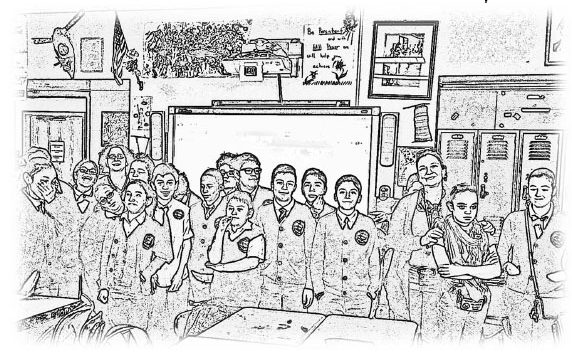T&W Magazine editorial board selected Julie Albright’s “Some Victorious Answer to Everything” as the 2022 Bechtel Prize runner-up. The prize was awarded for an essay describing a creative writing teaching experience, project or activity that demonstrates innovation in creative writing instruction.
The Bechtel prize is named for Louise Seaman Bechtel, who was an editor, author, collector of children’s books, and teacher. She was the first person to head a juvenile book department at an American publishing house. As such, she took children’s literature seriously, helped establish the field, and was a tireless advocate for the importance of literature in kids’ lives. This award honors her legacy. For more information, visit https://twc.org/bechtel-prize.
I love Bill Murray so thoroughly that I hosted an annual Bill Murray party for ten years. I’ve loved him since I first watched Saturday Night Live during a third-grade sleepover at Meg Waterman’s, a house with a glamorous sunken living room, where I laughed even though I was far too young to fully get the jokes.
It’s no surprise, then, that my fandom led me to a video of Bill reading poetry in a public square. In the video, a small crowd listens to him share Lawrence Ferlinghetti’s poem “Dog,” while a cellist playing Bach accompanies him. Bill was in Austin at the time, attending the SXSW Festival and promoting his movie Isle of Dogs, if the internet is right. In the video, he wears overalls.
I immediately knew I’d use “Dog” for a writing prompt in one of my workshops. For many years, I’ve operated this way: I come across a poem I love, and something about its format or imagery seems like a good model for student writers, or its subject matter reads like an invitation. I decided to use the Ferlinghetti in creative writing workshops I teach for third through twelfth grades. My presentation would vary with each age group, naturally, but I knew that we could all use “Dog” as a springboard. Though I do love poetry written specifically for kids, and I’ve built many lessons from poems by writers like the marvelous Eloise Greenfield, I’m often drawn to poems that might, at first glance, seem too adult or too “old” for young writers. I’ve found over and again that they rarely are. Obviously, some poems cover subjects that children are not ready to absorb—I’m not talking about these; I’m thinking, rather, of the rich subjects we might overlook because the poem’s packaging seems too sophisticated. I’m talking about allowing space for young writers to engage with poetry freely, sans age limits, sans expectations that they will digest every single detail.
And so, when I use a poem like “Dog,” I know that I might have to explain some vocabulary, and I might have to give the work some context, but when students use a poem as a template for their own writing, their hesitancy vanishes. It’s like a magic trick. Like understanding that Bill Murray is funny even if you can’t dissect why.
Here’s a link to the poem in full: “Dog” by Lawrence Ferlinghetti
In my writing workshops, I let Bill lead the way. Without much introduction, I play the video of his street reading, and I watch the students’ faces. Many of them have never even seen a Bill Murray movie, but most of them are riveted by his reading. Everyone loves Bill.
After we watch the video, I ask for reactions and ask if any images or words stuck in their heads. Of course they say, “the dog trots freely in the street!” and we’re reminded how effective repetition can be. Older students, or even eager younger writers, might learn the term anaphora now. But everyone can hear it, no matter what it’s called.
Next, we go over some of the unfamiliar terms and vocabulary and put the poem against a backdrop. Elementary students are not likely hanging out in poolrooms or committing perjury. No one knows that Congressman Doyle was a California senator involved in the House Un-American Activities Committee. (I had to look that one up, too.) But if Congressman Doyle is a fire hydrant for this trotting dog—well, we all know we don’t like Doyle. I show the students a picture of the Victor Records dog and tell them that a gramophone is a record player, and then sometimes, the occasional peril of this exercise, I have to explain what records are. My students remind me that I am one thousand years old.
Now that we’ve familiarized ourselves with the poem’s language, I read it again, aloud. From there, we make like the dog, “investigating everything” this poem offers.
We talk about strong verbs—I ask one student to demonstrate a trot, and then we brainstorm other verbs of motion and talk about the mood they create as we act them out. How is slithering different from shuffling? How is soaring different from waddling?
We talk about the senses in the poem—the cigars, the dog smells, the headless chickens, the Ravioli factory, the wondrous hollow horn—and talk about their effects. We point out the alliteration of Chinatown and chickens, among others.
We talk about meaning. Is the poem just about a dog? Does the dog represent something else? Even without extensive knowledge of the poem’s time period or political underpinnings, younger students can spot the power dynamics— “he has his own dog’s life to live”—and the pull between freedom and repression— “he has his own free world to live in”! High school students can make connections with today’s news, today’s police, our congress, our fragile democracy. Even a seven-year-old can feel the symbolic exhilaration of a walk without a leash. Older students might also dig a little deeper into the line breaks and spacing—but again, the younger students are just as able to see how the words start to spread out in the last portion of the poem, and how they curve like a question mark.
Last, and perhaps most important, we talk about perspective. How does our movement through the world influence what we see? Our age? Our location? As the dog noses his way along the street, he has something to say about his own reality, “something to say/about ontology.” Inevitably, one kid thinks “ontology” has something to do with cancer, but when I say that it’s just about the big questions of life, they all get it. We’re all trying to answer these questions from our own perspective, whether we’re eight, eighteen, or, like I am, one thousand. I ask students to think about the dog’s point of view. Certain and serious about the tale he has to tell, he is situated in some middle ground, as the “things he sees/are bigger than himself” and “smaller than himself.” I’m beginning to think this middle space is where we all permanently reside.
Primed now to write, the students revisit the first line of the poem. With the younger ones it’s enough to break it down into character (dog) + action (trots) + describing word (freely) + place (in the street.) Older students can identify the adverbs and prepositional phrases. And then it’s time to write our own poems. As they’re choosing a subject, I ask if there’s any larger meaning they want to create—do their characters’ travels, like the dog’s adventure through the street, represent anything, or are they meant only as a journey of the senses?
I’m often drawn to poems that might, at first glance, seem too adult or too “old” for young writers. I’ve found over and again that they rarely are.
Many young writers choose animals. Some are joyfully dynamic, “a hawk glides freely through the forest,” and some (particularly the high schoolers) are contemplative: “the wolf glances silently into the stars.” Some write about invented animals like the combination unicorn/fly, the unifly, who “flies happily through a cloud.” They choose humans, “the boy writes quietly in his room,” and non: “the alien walks gently on the moon.”
And the younger grades reliably embrace the absurd. “The French fry creeps cautiously through the street.”
The rest of the poems tumble out. I write with the students. No one is stumped. These writers know what to do. Everyone’s got their own fleas to eat.
Before finding the Bill Murray video in 2018, I’d never read this Ferlinghetti poem. Had I read any Ferlinghetti? I had that moment of imposter syndrome I get from time to time: did everyone know “Dog” but me? How can I call myself a writing teacher when I’ve not read…everything? I know I’m not alone in my doubt. I remember the seventh grader who asked, “When will I be a real writer?” I remember analyzing “All the world’s a stage” with a tenth grader, who was shocked when I could recite “Sans teeth, sans eyes, sans taste, sans everything.” She confessed, “I just didn’t know that Shakespeare was that well known.”
How perfect that she would enter a new stage of comprehension while reading Shakespeare’s chronology of a human life from infancy to oblivion! She was mortified, but she also wrote a solid paper on As You Like It. Maybe now that’s she an adult, that moment of revelation has become meaningful.
I strain against the idea that we should somehow know…everything and yet simultaneously be a pristine canvas from which complete originality springs. Sometimes in my workshops, a student will ask me if mimicking a poem is somehow cheating. “Am I allowed to do this?” they worry, pencil hovering above notebook. Are we frauds?
We are not. In my workshops, at least, we are the dog trotting freely in the street. The things he sees, the things we see, are reality. I’d argue that reality is also the things we feel without explicit understanding or the things we know without full articulation. Some things are bigger than we are, but they can still shape us. The late-night jokes, the progression of a free verse, the act of authoring our own words. Some things are smaller than we are, but we can acknowledge their place in the larger fabric. They are “the ants in holes,” each just one momentary story in a universe of stories whose meaning might shift with time. I hope the students can see themselves as writers, poets, storytellers playing many parts on the stage of life. I want us to be living question marks who also write unfettered—confident that we know everything we need to know at this moment in time.
During the second year of the pandemic I watched a virtual Theater of War production in which Bill Murray and other actors read and discussed the Robert Hayden sonnet “Those Winter Sundays.” The guy who blew up gophers in Caddyshack read the most quietly stunning poem. He’s an actor; he can do it all—but I wondered if Bill ever had those moments of self-doubt my students and I have from time to time. Does he ever feel like a fraud?
Hayden’s poem describes his father getting up every day, even Sundays, to start the fire that drives the cold from the house. The poem’s speaker is filled with regret that no one ever thanked the father for this and his other acts that kept a family going. “What did I know,” the poet writes, “of love’s austere and lonely offices?” The child is indifferent to the cracked and aching hands that polish his shoes. The child does not understand the sacrifice of a man who rises in the “blueblack cold” to heat the house, but he feels the warmth of the blaze. Only the grown man, the poet, knows all about love’s devotion.
Some things are bigger than we are, but they can still shape us.
After we draft our “Dog” poems, we revise so we can put together an anthology after our workshop ends. Students add a line break here, drop an article there, beef up their sensory details, eliminate ineffective repetition and keep the anaphora that sings. The “Dog” template has taken on a new life, and each poem, as all teachers expect and relish, is different than the next. The students who want to read their poems aloud do so, and we find gems in each.
I’ve been teaching creative writing for thirty years. I started teaching “Dog” at year twenty-five. Reading poetry is the best and most fertile way I know to find new exercises and ideas, and using poems as inspiration is one of the best ways I know to throw off the muzzle of insecurity about writing. Poetry—like Ferlinghetti’s dog, like Billy Murray reading in a public square—reminds us that we all have “something to say about reality.”
I haven’t yet heard the gramophone spout the answers to everything. I know I won’t hear that music before the “second childishness and mere oblivion.” But I do find partial answers in the dog, whose confident trotting reminds me that we don’t have to know it all to still know enough. It’s certain we’ll never fully piece together this puzzling existence, so why not let the young ones try?
Julie Albright created and runs The Writing Studio in Pittsburgh, where she teaches creative writing workshops for kids and provides editing and tutoring services. For the last thirty years she’s taught writing workshops in community centers, public and private schools, and various arts organizations around town. Her fiction and nonfiction have appeared in publications including Third Coast, The Good Men Project, and Ducts. You can find her on social media. Her instagram is @writingstudiopgh. She is also on Facebook https://www.facebook.com/writingstudiopgh. For more details visit her website writingstudiopgh.com



